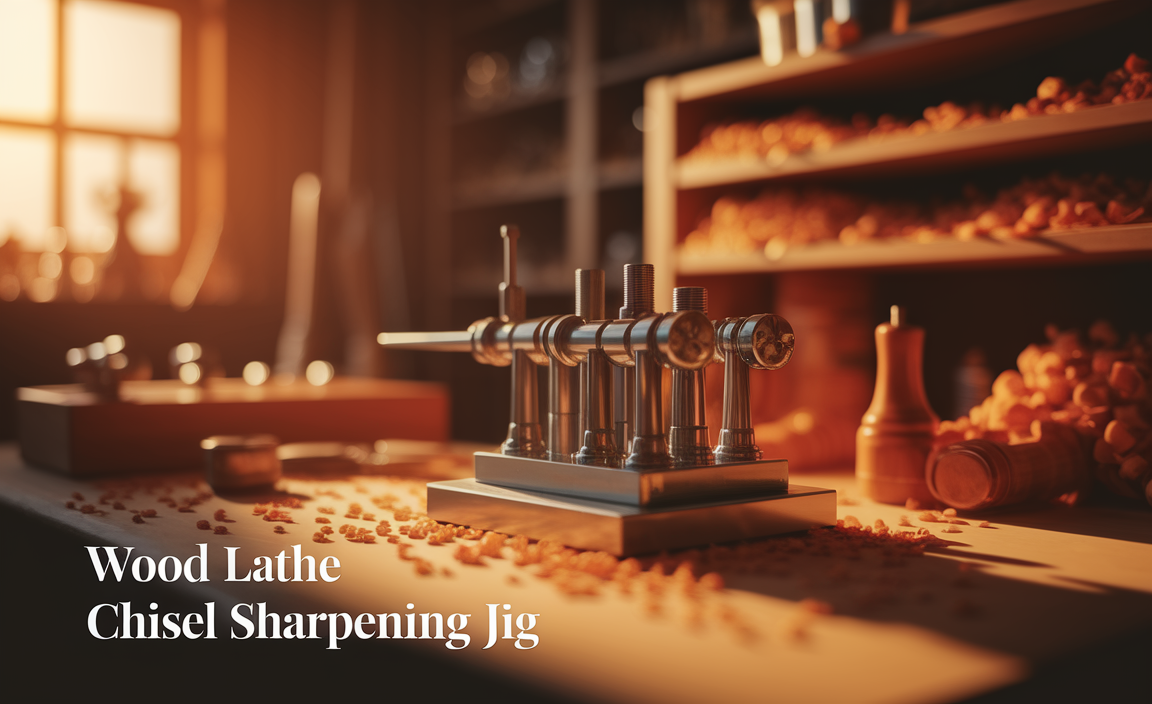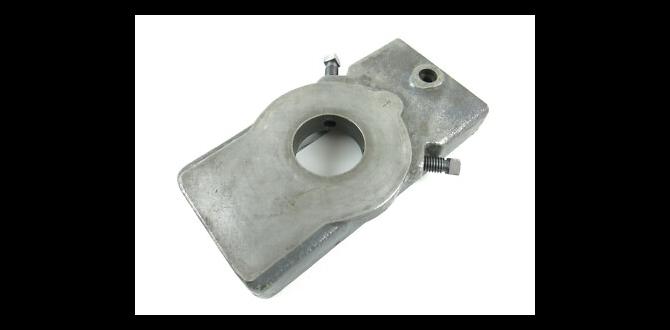Quick Summary: Precisely face tool steel like A2 using a TiALN ball nose end mill. Its durable coating and geometry handle hardened materials efficiently, reducing chatter and improving surface finish for your projects. Learn the exact steps to achieve professional results safely.
Working with tough materials like tool steel can be daunting, especially when you need a perfectly flat surface. Tool steels, known for their hardness, can quickly dull standard cutting tools, leading to frustration and poor results. You might be wondering if there’s a reliable way to tackle this, particularly for creating smooth, flat faces on your parts. The good news is, with the right tool and technique, facing hardened tool steel becomes surprisingly manageable. This guide will walk you through exactly how to use a TiALN-coated ball nose end mill, a workhorse for this specific job, ensuring you get a clean, accurate finish every time. Let’s dive into making your machining challenges a thing of the past.
Why Tool Steel is Tricky to Face
Tool steels, like the popular A2, are designed to be durable and resist wear. This makes them fantastic for making tools like dies, punches, and molds. However, this very hardness presents a challenge when you need to machine them. Typical machining processes can generate a lot of heat, which can soften the tool steel in ways that make it gummy and difficult to cut cleanly. Without the right cutting tool and parameters, you’ll likely experience rapid tool wear, poor surface finishes with visible scoring, and even chatter, which is that annoying vibration that ruins your part. It’s enough to make anyone rethink their approach!
Enter the TiALN Ball Nose End Mill
When you face hardened tool steels, you need a cutting tool that can withstand high temperatures and extreme wear. That’s where the TiALN (Titanium Aluminum Nitride) ball nose end mill shines. The TiALN coating is a game-changer. It’s applied as a thin layer on the cutting tool, providing:
- Superior Hardness: Significantly increases the tool’s resistance to wear, keeping it sharper for longer.
- High-Temperature Resistance: It forms a protective oxide layer at high temperatures, preventing the cutting edge from softening and degrading. This is crucial when cutting hard materials that generate heat.
- Reduced Friction: The coating helps materials like tool steel slide more easily over the cutting edge, reducing built-up edge (BUE) and improving chip flow.
The “ball nose” shape is equally important for facing. Unlike flat-bottomed end mills, a ball nose has a rounded tip. This means it always engages the material at a tangent, creating a smoother cutting action. For facing operations, especially on materials that are prone to vibration, this rounded profile helps to:
- Minimize Chatter: The continuous engagement and disengagement of the cutting edge helps dampen vibrations.
- Create Smooth Surfaces: By taking small, overlapping steps, the ball nose can leave a very fine, almost polished surface finish.
- Handle Uneven Surfaces: If your part isn’t already perfectly flat, the ball nose’s geometry can gently blend and smooth it out as it cuts.
For hardened tool steels like A2, a 50-degree ball nose end mill is often recommended. The 50-degree angle provides a robust cutting edge that can handle the forces involved in cutting these tough materials while still offering good surface finishing capabilities. You can find excellent resources on cutting tool coatings and geometries from organizations like the National Institute for Metalworking Skills (NIMS), which emphasizes the importance of tool selection for different materials.
Choosing the Right TiALN Ball Nose End Mill
Not all TiALN ball nose end mills are created equal. When selecting one for facing tool steel, consider these factors:
Material Quality and Coating
Look for end mills made from high-quality carbide. Carbide is strong and can withstand higher cutting speeds and temperatures compared to high-speed steel (HSS). Ensure the TiALN coating is applied uniformly and is of good quality. Reputable manufacturers will specify the grade of carbide and the coating process.
Helix Angle
While many ball nose end mills have a standard helix angle (often around 30 degrees), some specialized ones might differ. For general facing of tool steel, a moderate helix angle is usually a good balance. It helps with chip evacuation and allows for a reasonable cutting engagement.
Number of Flutes
For softer materials, more flutes (like 4 or 6) can provide a smoother finish. However, when machining tough materials like hardened tool steel, it’s often beneficial to use an end mill with fewer flutes, typically 2 or 3 flutes. Fewer flutes provide more chip clearance, which is essential to prevent chip packing and overheating in hard materials. This also allows for a more robust cutting edge that is less prone to chipping under heavy loads.
Diameter
The diameter of the end mill should be appropriate for the size of the feature you are trying to face. For general facing of larger surfaces, a larger diameter end mill might seem efficient, but it can also create larger forces. Often, a mid-range diameter (e.g., 1/2 inch or 12mm) offers a good balance of material removal rate and manageable cutting forces when facing tool steel.
Specific Grade for your Tool Steel (e.g., A2)
While a general TiALN ball nose end mill will work, some specialized tool holders or end mills are designed with specific tool steels in mind. For A2 tool steel, which is typically hardened to around 58-62 HRC, you need a tool that can handle those hardness levels. The 50-degree ball nose is good, but always check the manufacturer’s recommendations for optimal use with your HRC (Hardness Rockwell C) range.
Setting Up for Success: Essential Tools and Checks
Before you even think about turning on the machine, a proper setup is crucial for safety and precision. Here’s what you’ll need:
Essential Tools & Equipment:
- Milling Machine: A sturdy, well-maintained vertical or horizontal milling machine.
- Rigid Workholding: A vise that is securely clamped to the table, or a fixture that firmly holds your workpiece. Loose parts are dangerous.
- Tool Holder: A quality tool holder (e.g., ER collet chuck, Weldon shank holder) that provides a secure and concentric grip on the end mill.
- Depth Micrometer or Caliper: For accurately measuring your tool stick-out and for verifying depth.
- Dial Indicator: To check workpiece and machine tram, and to verify tool runout.
- Safety Glasses and Face Shield: Non-negotiable. Always protect your eyes!
- Workpiece Clamping: Ensure your part is clamped securely enough to withstand cutting forces without shifting. Shims and clamps are your friends here.
Pre-Operation Checks:
- Machine Tram: Ensure your milling machine head is perpendicular to the table (trammed). This prevents runout and uneven cutting. Refer to your machine’s manual or reliable sources like Machinery Lubricants for detailed instructions.
- Tool Runout: Check that your end mill is running true in its holder. Excessive runout will lead to poor finish and premature tool failure.
- Workpiece Squaring: Make sure your workpiece is square and securely located in your vise or fixture.
- Coolant/Lubrication: For tool steel, a good cutting fluid is essential to manage heat. Flood coolant is ideal, but a good quality soluble oil or even a specialized misting system can work. Some advanced machining shops might use specific dry-machining strategies combined with airflow, but for beginners, lubrication is key.
Step-by-Step Guide: Facing Tool Steel with a TiALN Ball Nose End Mill
Now, let’s get to the actual machining. This process focuses on safety, accuracy, and achieving that fine finish on your tool steel.
Step 1: Secure the Workpiece
Place your tool steel workpiece (e.g., A2) securely in your vise or fixture. Ensure it’s clean and that the clamping surfaces are free of debris. Tighten the vise firmly but avoid crushing the workpiece. Use parallels if needed to keep the vise jaws from marring your part. Make sure the surface you intend to face is accessible and clear of obstructions.
Step 2: Install the End Mill
Insert your TiALN ball nose end mill into a clean, quality tool holder. Ensure the shank of the end mill is properly seated and tightened. Install the tool holder into the milling machine spindle. Verify that there is minimal runout by using a dial indicator.
Step 3: Set Z-Axis Zero
Bring the tip of the ball nose end mill down to just kiss the highest point of the surface you want to face. You can do this by feel, using a piece of paper between the tool and the part, or an electronic tool setter. Once you’ve found the exact surface height, set your machine’s Z-axis zero. This is your reference point for all depth-related dimensions.
Step 4: Determine Your Cutting Parameters
This is critical for success. Machining hardened tool steel requires slower speeds and feeds than softer metals. As a starting point, consult your end mill manufacturer’s recommendations. If none are available, a common range for TiALN-coated carbide end mills on hardened steel (like A2 at 58-62 HRC) might look something like this:
| Parameter | Typical Starting Value (for 1/2″ or 12mm Ball Nose) | Notes |
|---|---|---|
| Surface Speed (SFM) | 50 – 150 SFM (15 – 45 m/min) | Lower end for harder steels, higher end for less hard. |
| Spindle Speed (RPM) | 380 – 1150 RPM | Calculated from SFM and diameter. |
| Feed Per Tooth (IPT) | 0.001″ – 0.003″ (0.025 – 0.075 mm) | Crucial for smooth cutting. Start low. |
| Depth of Cut (DOC) | 0.010″ – 0.050″ (0.25 – 1.25 mm) | Smaller DOC is safer for hardened steel. |
| Stepover (for Facing) | 20% – 50% of tool diameter | Smaller stepover for better finish. |
Important Note on Safety and Best Practices: Always start conservatively. It’s better to take a slightly lighter cut and have the tool last, than to push too hard and break the tool or damage the workpiece. For a beginner, using a smaller stepover (e.g., 20-30% of tool diameter) will result in a much better surface finish and put less stress on the tool. Always ensure you have adequate chip evacuation and coolant flow.
Step 5: Perform a Test Cut (Optional but Recommended)
If possible, try a shallow test cut on a scrap piece of the same material or on a less critical area of your part. This helps you verify your cutting parameters and listen for any signs of trouble like harsh noises or excessive vibration. You can use a depth micrometer to check the cut depth and feel the surface finish.
Step 6: Begin Facing Operation
Start the spindle and coolant. Engage the feed. For facing, you’ll typically move the end mill across the surface in a series of overlapping passes. You can:
- melakukan concentric passes: Starting at the center and working outwards in circles.
- melakukan raster passes: Moving back and forth in straight lines, with each pass slightly overlapping the previous one.
Set your machine to move at the calculated feed rate. For clarity, the target feed rate is often calculated as: Feed Per Tooth (IPT) x Number of Flutes x Spindle Speed (RPM) = Feed Rate (IPM).
The ball nose geometry means that the cutting load is distributed, and the tool engages the material smoothly. As you make passes, you should aim to remove just enough material to achieve your desired flat surface. Keep an eye on chip formation – they should be relatively small and not fused together. Listen for any unusual sounds!
Step 7: Make the Finishing Pass
Once you’ve removed the bulk of the material, you can make a final “finishing pass.” This pass should take a much lighter depth of cut (e.g., 0.005″ – 0.010″ or 0.12 – 0.25 mm) at a slightly faster feed rate (if your tool or machine can handle it smoothly) to achieve the best possible surface finish. The TiALN coating and the ball nose geometry are designed to leave a smooth, almost polished surface when used correctly during this final stage.
Step 8: Inspect the Result
Once the machining is complete and the spindle has stopped, clean the workpiece and inspect the faced surface. It should be smooth, flat, and free of any scoring or chatter marks. Use a straightedge and feeler gauges, or a surface comparator, to verify flatness. The surface finish should be significantly improved compared to what you might achieve with standard end mills on hardened tool steel.
Troubleshooting Common Issues
Even with the right tools, you might encounter a few bumps in the road. Here are some common issues and their solutions:
- Chatter:
- Cause: Too high a spindle speed, too aggressive feed rate, tool deflection, loose machine components, or workpiece not held rigidly.
- Solution: Reduce spindle speed, increase feed per tooth slightly (but not too much), decrease depth of cut, ensure tool holder is secure, check machine rigidity, and ensure workpiece is clamped tightly. A smaller stepover can also help.
- Poor Surface Finish (Scoring, Gummy Surface):
- Cause: Insufficient coolant, cutting too dry, feed rate too low (rubbing instead of cutting), worn tool, or material is too hard for parameters.
- Solution: Increase coolant flow or use a better lubricant. Increase feed per tooth slightly. Ensure you are using appropriate cutting speeds and depths of cut for hardened steel. Check tool for wear; a TiALN coating can be damaged.
- Tool Breakage:
- Cause: Aggressive feed rates/depths of cut, poor chip evacuation leading to re-cutting chips, tool entering material too fast, sudden impact.
- Solution: Significantly reduce feed and depth of cut. Ensure adequate chip clearance. Use a slower feed rate on the entry into the material. Make sure the machine is properly trammed and the tool has minimal runout.
- Excessive Heat:
- Cause: Insufficient coolant, high spindle speed/feed rate, dull tool.
- Solution: Increase coolant flow. Reduce cutting speed and feed. Ensure your TiALN end mill is sharp and in good condition.
Beyond Just Facing: Other Applications
While we’ve focused on facing, the TiALN ball nose end mill is a versatile tool for tool steel and other hard materials. Its geometry makes it excellent for:
- Slotting: Creating slots with rounded bottoms.
- Profiling: Machining external shapes with rounded corners.
- Engraving: Creating detailed designs or text with a smooth finish.
- 3D Contouring: Its rounded form is ideal for creating complex curved surfaces in molds and dies.
For any of these applications on hardened materials, remember that the same principles of rigid setup, appropriate cutting parameters, and effective lubrication apply. For more advanced 3D contouring, you might explore specialized CAM software strategies and potentially smaller diameter ball nose end mills for intricate details.
Conclusion
Facing hardened tool steel, like A2, no longer needs to be a source of anxiety. By understanding the capabilities of a TiALN-coated ball nose end mill and following a systematic approach, you can achieve professional-grade results right in your workshop. Remember the key elements we discussed: selecting the right tool for the job, ensuring a rigid setup, carefully choosing your cutting parameters, and prioritizing effective lubrication and chip evacuation. With these practices in place, you’ll be confidently tackling tough materials, creating perfectly flat surfaces, and taking your machining projects to the next level. Happy milling!
Frequently Asked Questions (FAQ)
Q1: What is the main advantage of using a TiALN coating on an end mill for tool steel?
The TiALN







